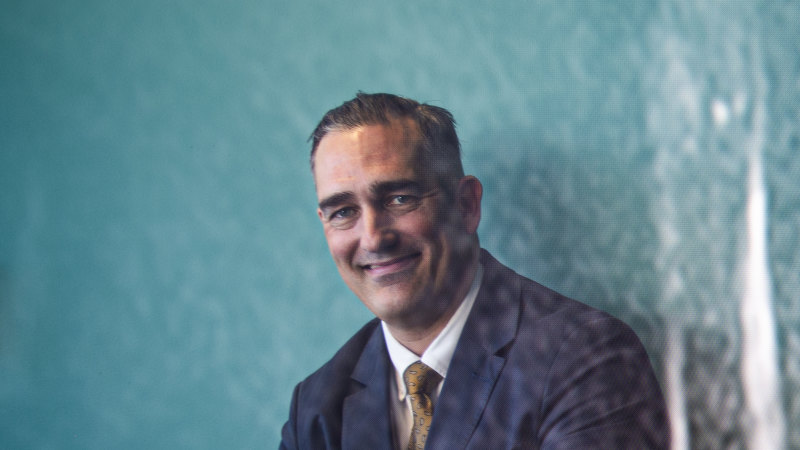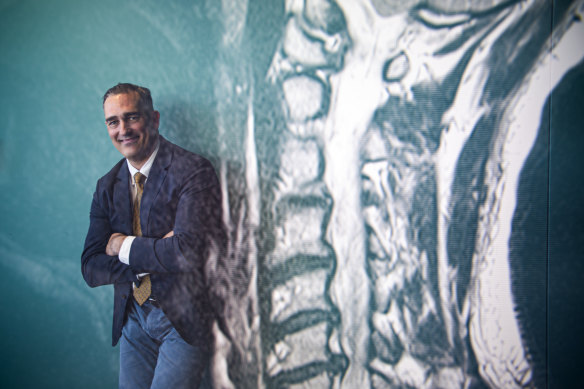Jim sneezed. Then his arm went numb

Save articles for later
Add articles to your saved list and come back to them any time.
In his work, Professor Jim Elliott, academic director of NSW Health’s Kolling Institute, has heard many dramatic stories of injury.
The University of Sydney professor of allied health is one of the world’s foremost researchers on neck pain and whiplash, authoring more than 200 peer-reviewed articles on the topic.
In August, whiplash researcher Professor Jim Elliott suffered his own injury. Credit: Sam Mooy
Such injuries are typically associated with a traumatic blow; a car crash or significant fall. But earlier this year, when Elliott found himself no longer a researcher at a desk but a patient on an operating table, the circumstances were much less dramatic.
“Unfortunately, my injury was a massive sneeze,” he said.
Within seconds the previously healthy 54-year-old knew something was wrong.
“I had an immediate zinger down my right arm, and I just thought: Oh, that didn’t feel so good.”
Having done hundreds of cervical MRIs on his neck for research purposes, Elliott knew he had some age-related degenerative disease in the discs in his neck, but it had never caused him any trouble before.
“The sneeze was clearly just enough to put me over that threshold,” he said.
After the immediate nerve jolt, over the next two days the tingling in his right hand and arm became numbness. He started taking anti-inflammatories, but his neck pain only got worse. Next stop was physiotherapy.
“I was faced with this: Oh my god, I’ve been studying this phenomenon for 20 years and now suddenly I’m walking in the shoes of a patient.”
A key part of Elliott’s research focuses on why some, but not others, recover from a traumatic injury. With his tingling and numbness persisting, Elliot was reassured to remember the majority did.
In whiplash from motor vehicle crashes, for example, half of patients recover rapidly. But about a quarter of patients transition from acute to chronic pain and disability.
“I went into conservative physiotherapy thinking I would be one of those people who spontaneously recovers, and I wasn’t,” Elliott said.
Knowing a patient should see a specialist if pain does not subside after six weeks, the professor saw a neurosurgeon. An MRI found he had severe multi-level foraminal stenosis – where the area around a nerve is compressed, placing pressure on the nerve – with disc extrusion.
“The neurosurgeon said to me, ‘You and I both know this is not going well’.”
It was decided Elliott would have an anterior cervical disc fusion. The operation – which begins with an incision through the front of the neck – essentially creates space between vertebrae to free up the nerve, and prevent the contact which impacts sensation.
“When I woke up in recovery I could feel my hand again, which was a huge relief for me,” he said.
“But I’m not quite out of the woods yet.”
A month after surgery, Elliott said it has been “really fascinating” to observe the recovery within himself. By putting the space between his vertebrae, for example, the normal curve in his neck has been increased, and with it has come some upper back pain as his body adjusts to the shift in balance.
With a four-centimetre scar across the front of his neck, Elliott returned to the office this week with a new appreciation for his work.
“I understand now how absolutely crucial it is to have the patients’ input into our clinical care, and our research,” he said.
As for big sneezes, Elliott says there is probably not much to be learnt; just another story about an injury that researchers are still uncovering the mysteries of.
“I would never suggest to anyone that you’ve got to contain your sneezes – this was probably just the one thing that put me over the edge.”
Start the day with a summary of the day’s most important and interesting stories, analysis and insights. Sign up for our Morning Edition newsletter.
Most Viewed in National
From our partners
Source: Read Full Article
